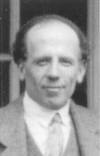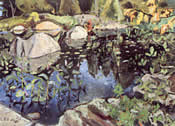ARTHUR LISMER
1885 - 1969
 Arthur
Lismer's immense contribution to Canadian art is twofold: as a painter
and as an influential and dedicated art educator. A man of tireless
energy, his active career took him throughout Canada and around the
world. He saw art as a universal form of expression, profoundly rewarding
for all who took the time to enjoy it.
Arthur
Lismer's immense contribution to Canadian art is twofold: as a painter
and as an influential and dedicated art educator. A man of tireless
energy, his active career took him throughout Canada and around the
world. He saw art as a universal form of expression, profoundly rewarding
for all who took the time to enjoy it.
Born in Sheffield, England, and apprenticed at thirteen to a photo-engraving firm, Lismer spent the next seven years producing black and white art for the local newspaper while studying at the Sheffield School of Art. Further courses at Antwerp's Academie des Beaux Arts, combined with trips to London and Paris, gave the young student a thorough background in both art history and in the traditions of the day. Struggling as a commercial artist, he soon headed to Canada where he joined the design house of Grip Ltd. in 1911 where he met artists Frank Johnston, J.E.H. MacDonald and Tom Thomson. He was one of four employees , who later formed the Group of seven, to leave work for Rous and Mann printing house in 1912.
Lismer first visited the Georgian Bay area in 1913 when he was offered the use of a cottage owned by Lawren Harris's friend Dr. James McCallum It was an initiation to a landscape favoured by the artist for the rest of his life. The following year Lismer journeyed for the first time to Algonquin Park, where he and Thomson sketched together. Lismer felt that this was turning point in his life. Lismer's impressionistic style of these earlier years seemed inappropriate for the rugged landscape, and throughout the 1910s, he developed a technique of stronger colour and compositional design.
 Arthur
Lismer was a man of considerable energy - a gregarious, outgoing individual,
always ready with a witty or caustic remark. Nothing delighted him
more than taking a crack at the establishment or at anything that
hinted at pretension. His spirit and energy made Lismer fight against
the apathy and ignorance of the public towards the world of art. He
did this by dividing his time between painting and teaching. In 1916,
he began his lifelong career in teaching, as principal of an art school
in Halifax. In his teaching, Lismer's passion was devoted to children's
art, and in his painting it was the Canadian landscape. In both cases,
he went at the task in a bold, colourful way.
Arthur
Lismer was a man of considerable energy - a gregarious, outgoing individual,
always ready with a witty or caustic remark. Nothing delighted him
more than taking a crack at the establishment or at anything that
hinted at pretension. His spirit and energy made Lismer fight against
the apathy and ignorance of the public towards the world of art. He
did this by dividing his time between painting and teaching. In 1916,
he began his lifelong career in teaching, as principal of an art school
in Halifax. In his teaching, Lismer's passion was devoted to children's
art, and in his painting it was the Canadian landscape. In both cases,
he went at the task in a bold, colourful way.
After World War I he returned to Toronto, where he was appointed vice-principal of the Ontario College of Art, a post he held until 1927. In that year he moved to the Art Gallery of Toronto (now the Art Gallery of Ontario), where he began a distinguished career in innovative gallery programs. Lismer retired as principal of the Montreal Museum of Fine Arts in 1967.
During his career Lismer lectured across Canada and in New York, South Africa, and the South Pacific. Over the years he touched thousands, no doubt altering their outlooks forever. He believed passionately that the pursuit of art and education made life richer with the ability to "see further and deeper than others into the meaning and beauty of life".
Despite his full schedule, Lismer never gave up his interest in exploring the Canadian landscape of northern Ontario and Quebec. For Lismer Canada provided "a background of epic grandeur". He interpreted the natural world with a style suitable to the ruggedness of the landscape.
Sources: The National Gallery and 'The McMichael Collection'